#detective kosuke kindaichi
Explore tagged Tumblr posts
Text
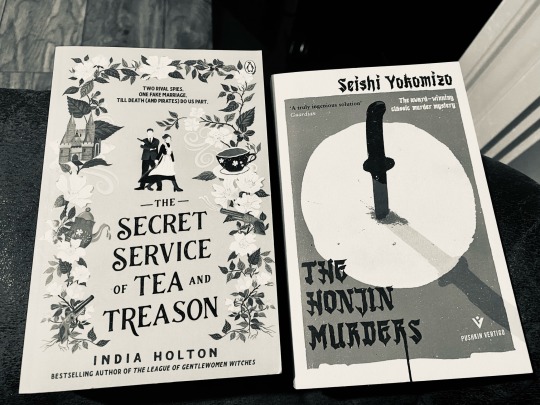
Newly acquired:
The Secret Service of Tea and Treason by India Holton
The Honjin Murders by Seishi Yokomizo. Translated by Louise Heal Kawai.
#fiction#reading#books#currently reading#the secret service of tea and treason#india holton#romance#historical fiction#spy fiction#fantasy#humour#witches#dangerous damsel series#the honjin murders#seishi yokomizo#mystery#crime fiction#detective kosuke kindaichi#japan#japanese literature#classics#thriller#detective
1 note
·
View note
Text




various sketches
50 notes
·
View notes
Text
I’ll Teach You How To Pull Off The Perfect Crime Part 2 ~The Inugami Chapter~ (English Translation)
youtube
完全犯罪伝授します弐〜犬神篇〜 Music/Lyrics: Joruzin Video: unrefle Vocals: GUMI, Kagamine Len
"The continuation to “I’ll Teach You How To Pull Off The Perfect Crime”.
His outer face is that of the eccentric who runs the used bookshop, his inner face is that of a master missionary of perfect crimes, a one Sano Shougai. Until now, all the perfect crimes he’s told people have been executed flawlessly, each and every time. His high intelligence could leave the police far outmatched. But in this case, for the first time, he learns of the existence of someone whose IQ could match, no, surpass his own.
“The Man Who Will Help Execute The Perfect Crime” VS “The Man Who Will Stop The Perfect Crime”
How will this case end?!"
-- original description
(extra translator's note: i stole parts of the translation from the vlyrics wiki translation of the first song in this series for continuity reasons, and linked where relevant. i hope op doesn't mind)
えぇ そうですか つまり相続権の独占ですね
Yes, I see. So you want to claim the inheritance to yourself.
遺産の全てをご子息に それが為なら殺しも辞さない
You want the inheritance to all be for your son, and you’re willing to go as far as to murder.
ではでは遺言と家系図を確認します
Then I’ll confirm the facts about the will and the family tree.
財界巨頭の犬神家の創始者左兵衛が身罷った 彼の遺した遺言書に一族狼狽その内容は
The founder of the Inugami Clan, renowned in the business world, Sahei Inugami, has kicked the bucket. The will he left behind has caused massive dismay in the family
一族以外の本筋の血の繋がりない生娘に遺産を全て譲渡する ただし娘の配偶者には
In it, it says that the inheritance is to all go to a virgin girl who isn’t even directly related to the family That is to say, to the spouse of that girl, Tamayo
犬神左兵衛の孫にあたる「佐清」「佐武」「佐智」の三名中から選ぶこと つまり珠世の愛を勝ちとったものが遺産を手に入れる しかしご子息佐清は戦時に負った顔の傷 醜い姿に成りさがった
Sahei Inugami has three grandchildren, Sukekiyo, Suketake and Suketomo that she will choose from In short, to win Tamayo’s love is to get the inheritance But your son Sukekiyo has become hideous as a result of injuries on his face from the war
愛されるはずもない ならば「佐武」「佐智」2名を葬りその���珠世に被せることで 佐清に遺産転がり込ませる
She certainly won’t love him. If that’s the case, you will bury “Suketake” and “Suketomo” and pin the crime on Tamayo so that the inheritance will come into Sukekiyo’s hands.
つまりそういうことですね 一族身内の殺害計画
So that’s what this is about, hm? A plan to murder members of your family…
思考 黙考 熟考 整いました After much thought, meditation, and deliberation, I have it all arranged for you.
完全犯罪伝授します お代は貴女の死因の決定権を小生が頂戴いたす それでよろしいですね? 完全犯罪伝授します 手段は電話でお伝えします 一族集まる月夜の晩に人の目ない部屋でおかけください なになに私立探偵が雇われているですと?まあ捨て置いて問題はないでしょう
I'll teach you how to pull off the perfect crime. The price is to let this humble one decide your cause of death Will that be okay with you? I'll teach you how to pull off the perfect crime. I’ll tell you everything over the phone. On the moonlit night when the whole family gathers, dial me in a room where no one can see you What’s that, a private investigator has been hired? Well, put that thought aside for now, it won’t be a problem.
「殺害の手引き」
“A Guide to Murder”
計画ポイント2つあり 「猟奇性」と「芸術性」 殺害現場に珠世の犯行を示唆する私物を残すことです
This plan has two points: it will be “grotesque” and “artistic” You will leave personal items on the murder scenes to suggest that Tamayo is the culprit.
「犬神家に強い恨みを持った珠世が遺産目当てに犯行に及んだ」 そうです美しく殺してあげましょう
“Bearing a grudge against the Inugami family, aiming to get the inheritance, Tamayo resorted to crime.” That’s how it will be, let us murder them beautifully
第一殺害タイトルは「菊人形頭衣替え」美しいですね あぁあぁ美しいです 第二殺害タイトルは「琴線天幕吊し上げ」美しいですね あぁあぁ美しいです
The first murder case will be called, “A Change of Head for the Chrysanthemum Doll”, beautiful, ah, ah, so beautiful! The second murder case will be called, “A Decorative Curtain Hung by the Strings of the Koto”, beautiful, ah, ah, so beautiful!
計画に狂いが生じた? 佐清だと信じた人物 全く別人 ���物佐清 潜伏していたところを
Has this plan sparked madness in you yet? It turns out the person you believed to be Sukekiyo is a completely different person The real Sukekiyo is hiding in wait
例の私立探偵が発見 偽物佐清正体 犬神左兵衛の愛人の息子 全てをたちどころに見破った!?
That private detective has discovered where he is and the true identity of the fake Sukekiyo—he is the son of Inugami Sahei’s lover Has he seen through us?!
大丈夫です落ち着きなさい 若干計画変更します 偽物佐清この計画を知るもの生かしてはおけませんから 第三殺害タイトルは「偽装すましの逆さ人」薬で眠らせ湖畔の浅瀬に頭から突き落とすのです 素晴らしいですね 全てが完璧です あぁ美しい それでは最後の仕上げに掛かりましょう
It’s alright, please calm down, we’ll just change the plan a little. The fake Sukekiyo knows your plans, so he cannot be left alive. So the third murder case will be called, “A Disguised Upside-Down Person”. You will drug him to sleep and push him head first into the shoals of the lake. So wonderful, it’s all so perfect, ah, it’s beautiful! Now let’s add the finishing touches
珠世の自室に青酸カリを忍ばせなさい それではお渡していた死因書を開封なさい
Do hide some cyanide in Tamayo’s room Then, please open the document I’ve given you with your cause of death
アリバイ工作で全ての犯行が可能だったのは珠世と貴女です 今から珠世にお茶を入れさせなさい その中にもうひとつ用意した青酸カリを 入れて飲みなさい つまり「今」から「自室」で「服毒自殺」をするのです 全て珠世の犯行と見做され財産佐清転がり込むでしょう
With the alibis you’ve made, the suspects will be Tamayo and you. Now let Tamayo pour you some tea that you laced with the same cyanide from before, and drink it. In other words, “now”, you must “kill yourself with poison” in “your room”. When Tamayo is considered the culprit, the estate will come into Sukekiyo’s hands, isn’t that right?
さあ受話器そのままで やるのです
Now, you will leave the phone aside and do it.
おやめなさい 全て貴女の犯行だと 解りました お話を伺います 貴女をそそのかした人の
Please stop this. I’ve figured out that this is all your doing. Could I ask to talk to the person who’s tempted you?
必ずアナタを突き止めます
I will definitely find you.
探偵風情!!
The likes of that detective…!
#gumi#kagamine len#vocaloid#完全犯罪伝授します#joruzin#じょるじん#translation#tw blood#tw murder#i'll make an article on the wiki later when i'm not as busy#but the detective here is a guy called kosuke kindaichi! he's like japan's version of holmes/poirot#the story this song is based on is indeed from a real book; except for the involvement of the guy with the basket for a hat (sano shougai)#Youtube
12 notes
·
View notes
Text

any other Yokomizo fans out there
#kindaichi kosuke#seishi yokomizo#theres a tag so maybe?#anyway i may start the inugami clan today#or reread gokumon-to#need my wacky detective guy rn
11 notes
·
View notes
Text
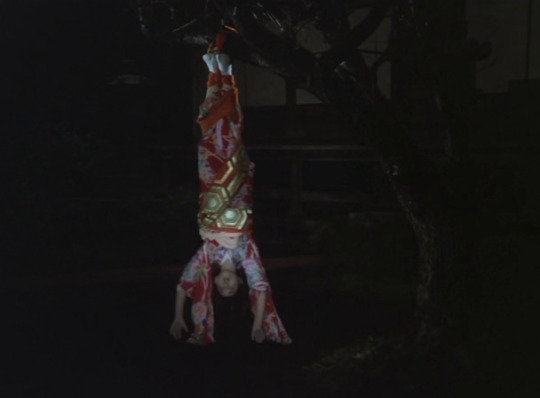



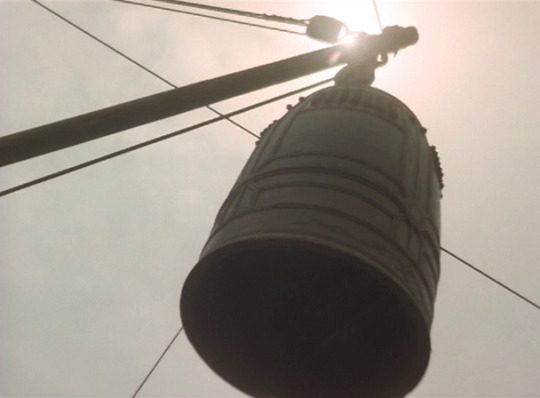
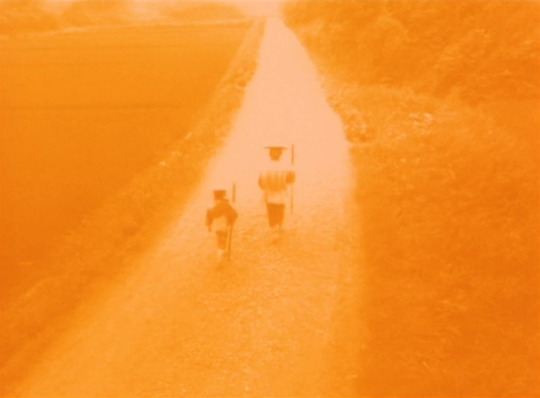



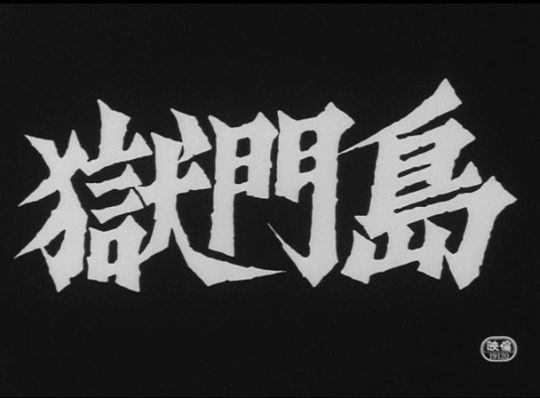
"There's a story behind this dreadful name."
獄門島 (Gokumon-to / Hell's Gate Island), 1977.
Dir. Kon Ichikawa | Writ. Kon Ichikawa & Shin'ya Hidaka | DOP Kiyoshi Hasegawa
#獄門島#Gokumon-to#hell's gate island#kosuke kindaichi#kindaichi kosuke#kon ichikawa#japanese film#detective film#crime drama#murder mystery#1970s#10 frames
18 notes
·
View notes
Text
「Ranpo, Mushi, Seishi」 – Tales from the Burgeoning World of Japanese Mystery
After re-reading Bungou Stray Dogs and with better understanding of the history behind the figures of Japanese Literature, I find myself falling further in love with the Perfect Crime Arc of the BSD Manga.

In a span of three chapters, Mushitarou went from an unknown to one of my favorite mystery authors out there. An outcast of the detective novel world often disregarded due to his pedantic and frankly bizarre way of writing his stories.
Further reading about his life made me realize that this arc is a complete recreation of a section of Mushitarou's life, the other authors he interacted within his short career and an everlasting impact between giants of the Early-Showa Detective Novel scene. It is shocking how Asagiri and Harukawa conceals and works with the details of the story so well, blending in so many different parts of his life into the manga.
The Lineup
To get a better feel of who the three main figures are in this story, I must first introduce the three main authors of this story.



Edogawa Ranpo (left), Oguri Mushitarou (center), Yokomizo Seishi (right)
Edogawa Ranpo (江戸川乱歩, 1894 –1965) was a detective novelist who made a name with his many detective novels which made him a key part of the mystery novel landscape even up to the modern day. He is most well known for creating the character of Akechi Kogorou who first appeared in The Murder on D Hill (D坂の殺人事件) and would later star in many of his novels.
Oguri Mushitarou (小栗虫太郎, 1901 - 1946) was a detective novelist who was known for his bizarre writing style. His use of difficult kanji along with furigana guides for many of his stories makes his works some of the most difficult works to read in Japanese. His most well known work is The Black Death Mansion Murders (黒死館殺人事件) along with the detective Horimizu Rintarou.
Yokomizo Seishi (横溝正史, 1902 - 1981) was a detective novelist who was a master of the 'honkaku' mystery genre. His work The Honjin Murders (本陣殺人事件) and detective Kosuke Kindaichi continue to be a staple of modern Japanese pop culture.
The Making of a Genre

Misery (無惨) by Kuroiwa Ruikou (黒岩涙香) is oft regarded as the first Japanese mystery novels which brought the genre into the public consciousness. A simple murder mystery tale of gambling seemingly gone awry. From this spark then came numerous authors such as Morishita Uson (森下雨村), Ooshita Udaru (大下宇陀児), Hamao Shirou (濱尾四郎) and an up and coming author named Edogawa Ranpo.
Ranpo made a name for himself with the publication of The Two-Sen Copper Coin (二銭銅貨) in 1923 which made him the undisputed 'king' of Japanese mystery novels. With this influential position, Ranpo's comments often brought attention to many other authors working withing the genre. Along with this, magazines geared towards younger readers such as Shin Seinen began to become popular as the youth of Japan became enthralled with tales of mystery and adventure.
The Perfect Crime — The Story and the Arc
Out of all of the arcs in Bungo Stray Dogs, I feel like the Perfect Crime Arc is one that nails the heart of Bungou Media at best; a transformative work about authors and their works, how they treated one another and how they stand in the world of literature. Many of the characters in BSD are very much based on their real-life counterparts such as Dazai and Ooba Youzou of No Longer Human (人間失格) and/or The Flowers of Buffoonery (道化の華) fame. Ranpo and Mushitarou both are great representations of their works and style but more importantly, their relationship tells of their time as mystery novelists.
While Ranpo continues to enjoy mainstream fame not only within but outside Japan as well, Mushitarou is often relegated to the less-mainstream, some would call him your 'favorite's favorite'. But there's a big reason as to why Mushitarou's so much less well-known in the west and it boils down to his writing style. An "absurd" use of furigana, stretching the limits of the Japanese language with an example below from his magnum opus, The Black Death Mansion Murder Case:

Heavy and difficult kanji along with the furigana of various foreign languages, a writing style derided by critics such as Sakaguchi Ango who called it as 'imitating the worst aspects of S. S. van Dine'. This quirk would also be adapted into the Bungou Stray Dogs manga as some of Mushitarou's dialogue is written the way the real-life Mushitarou's writing style

Mushitarou's connection with Dostoevsky may have also been derived further by the story of The Perfect Crime (完全犯罪) which sees Russian characters such as Vasily Zharov who was the leading character of the story.
The story behind the publication of Mushitarou's The Perfect Crime is the main inspiration behind the story of the Perfect Crime arc.
In Spring 1933 Oguri Mushitarou, then a young and new author, submitted a 600-page mystery novel script to Kouga Saburou (甲賀三郎). After reading through it, Saburou dismissed the script saying that it was far too long; recommending Mushitarou to submit something shorter. With this recommendation in mind, Mushitarou submitted the first draft of The Perfect Crime to Saburou which impressed his peer greatly. Saburou however, still felt as if it'd be something difficult to pitch to publishers and even considered enlisting the help of Edogawa Ranpo to get it published.
Saburou then went on and decided to send the draft to then editor of the Shin Seinen magazine, novelist Mizutani Jun (水谷準) who took a quick look and then dismissed the work entirely, putting it to his desk drawer and quickly forgetting it. Shin Seinen was at this point a hub for popular literature for young boys with detective and adventure novels galore with authors such as Yumeno Kyuusaku (夢野久作), Unno Juuza (海野十三) and even Kouga Saburou himself publishing their works in the magazine. Starting from its New Year 1933 issue, they planned to include at least a 100-page one-shot story from various authors.
Yokomizo Seishi, who was at this point one of Shin Seinen's star writers, got sick with hemoptysis which lead to the cancellation of one of his stories which was to be published in the July 1933 issue of the Magazine. With this, the July issue had lost its main story; that is until Mizutani Jun, who was in a scramble to find a replacement, remembered the manuscript which Mushitarou had sent in. He quickly realized that the script was about the length needed to cover for the issue and quickly read over the work. Mizutani then also assured Yokomizo that he should take a rest instead rather than forcing himself to write.
The following is the editor's note written by Mizutani for the publication of the story:
The 100-page "The Perfect Crime" was written by a complete newcomer. This month's edition was supposed to be written by Yokomizo Seishi, but the author suddenly became ill and was unable to write, so this work was substituted for him. As you will see upon reading it, this work is a truly excellent work of detective fiction. Readers may like or dislike the setting or the descriptions, but I hope you will read it to the very last line and congratulate this newcomer on his future prospects.
The Perfect Crime was indeed Mushitarou's debut work, its publication taking center stage and substituting the work of one of the most popular mystery novelists of the era. The fact that the work was deemed "worthy" to substitute Yokomizo's work itself is already high praise.
Yokomizo then also commented with the following after reading the story written by Mushitarou:
"Who could have ever found such a powerful pinch hitter*? Even if I had been in good health, I was not confident that I could write a masterpiece as fascinating as 'The Perfect Crime.'" *A Pinch Hitter is a substitute batter in baseball.
This publication marked the beginning of Mushitarou's friendship with Yokomizo. The two of them met in a bar where Mushitarou said that "Because of your illness, I was able to debut much faster." To which Yokomizo responded with "Don't be silly, you would have debuted regardless whether I was sick or not." Mushitarou then continued saying "That may be true, but regardless the opportunity came quicker because of your illness." Yokomizo then promised, "All right then, next time something happens to you, I'll be sure to cover for you."
The two would be separated for most of the war-time, with them writing letters back and forth about detective novels while continuing to publish works as Yokomizo fled to Okayama due to the outbreak of World War II. Despite Yokomizo ever hardly sending any correspondence during this period, he continued to reply to letters sent by Mushitarou. In early spring 1946, Yokomizo received a letter from Mushitarou saying that he was going to fully devote himself to writing full-fledged novels which Yokomizo agreed with.
After the war had ended, Yokomizo went back to the literary world where he would discover that Mushitarou had passed away suddenly due to Methyl poisoning in a telegram and Unno Juuza would later explain to him the full extent of Mushitarou's untimely death. This death shook Yokomizo and he was unable to do anything for the next few days, especially due to the letter sent by Mushitarou, clearly passionate about his coming works.
Due to Mushitarou's sudden death, Yamazaki Tetsuya (山崎徹也) who was the editor-in-chief of the magazine Rock needed someone to replace Mushitarou's work for the upcoming issue. Yokomizo, who was in the middle of serialization of "The Honjin Murders" in the magazine Houseki decided to 'cover' for Mushitarou and published "The Butterfly Murders" in the magazine.
"I was no match for you"

Edogawa Ranpo at this time as the mystery novelist of the time. Ranpo at this point had met and known many other mystery novelists from Ookura Teruko and once, even met up with Oguri Mushitarou as he wrote down in 40 Years of Detective Novels (探偵小説四十年)
According to Ranpo, the two of them met once in 1946 and in this conversation Mushitarou said to Ranpo, "Edogawa-san, it seems at the end I was no match for you." to which Ranpo then replied, "Not at all, you're a better writer than I am." Which was of course replicated at the end of the arc.
The Characterification of Oguri Mushitarou
In her paper 'No longer Dazai : the re-authoring and "character-ification" of literary celebrity in contemporary Japanese popular culture', Jaylene Laturnas describes the process of Characterification (キャラクター化) as follows:
Character-ification refers to the act of turning anything from living beings to inanimate objects and abstract concepts into characters via anthropomorphism and personification (gijinka) or caricature (deforume).
Bungou Stray Dogs of course, is of course, a series that takes these authors and characterizies them in the gijinka form as stated by Asagiri himself in a 2014 interview. While most characters in Bungou Stray Dogs are 'gijinka' of their works and characters, Mushitarou occupies an interesting space as his actions and characterizations leans heavier towards the real author and the events within his short literary career. There's a clear degree of difference between how Mushi is portrayed in the series in comparison to his other fellow authors as it leans so much closer to real-events than any other author has been depicted in the series (arguably, Kunikida's turbulent relationship with Sasaki Nobuko may be the closest thing but enough creative liberties have been taken to completely differentiate the real person and the fictional character). Even the ending to the arc with Ranpo's deduction of what actually happened is in reference to a real event between the two-real life authors. It makes me want more of this rather than the arc following these 3 chapters.
The depiction of Mushitarou's friendship with the already-dead-Yokomizo in the series is just excellent, I do think a core tenet of their real-life friendship is their willingness to do anything for one another, stemming from that fateful meeting through their debut. It makes sense how in the series that this willingness is taken to the very extreme. Real-life Yokomizo's illness and BSD Yokomizo's illness parallels one another in the sense that it both brought Mushitarou into the limelight, a 'debut' for both real-life Mushi into the literary world and a 'debut' for Mushi the character in Bungou Stray Dogs. His ability being named after his debut novel is also just like the cherry on top, every layer just perfectly slotting in so well.
To examine the characters' real-life and re-contextualize it in such a way that it fits the Bungou Stray Dogs framework, I honestly would like more of this going forward and I can only hope it does happen.
Afterword
I am so so very sorry this article took a while to finish, many sources are only in Japanese and for many of them I had to verify it. Along with graduating, job-hunting and also visiting Japan earlier this year, I was too busy and I overshot when I was going to finish this.
I can't help it though, I really do love Mushishi and his silly antics and his works have somewhat inspired me to write again too. I still plan on doing deep dives like these though I want to try and write about authors not in BSD.
Until then, adieu!
Sources used:
坂口安吾. 「推理小説論」 「新潮 第四七巻第四号」 1950(昭和25)年4月1日発行
小栗宣治. 「小伝・小栗虫太郎」 『日本探偵小説全集6 小栗虫太郎集』付録〈創元推理文庫〉(東京創元社、1987年)所収。
水谷準. 「作家をつくる話――なつかしき「新青年」時代」 新青年1985年2月新春特別号第32巻第1号
横溝正史. 「小栗虫太郎に関する覚書」
江戸川乱歩. 「探偵小説四十年」
Laturnas, Jaylene "No longer Dazai : the re-authoring and "character-ification" of literary celebrity in contemporary Japanese popular culture" (2023) UBC
朝霧カフカ & 春河 35 "【特集】 文豪で遊ぼう: 「文豪ストレイドッグス」原作者 & 漫画家インタビュー" 2014年4月
#japanese literature#bungou stray dogs#bungo stray dogs#bsd#bsd mushitaro#mushitaro oguri#bsd yokomizo#seishi yokomizo#ranpo edogawa#bsd ranpo
69 notes
·
View notes
Text
Kindaichi Shonen no Jikenbo N (金田一少年の事件簿N (Neo)) Whump List

Synopsis: High school student Kindaichi Hajime solves a variety of difficult cases that he gets entangled in with the deductive powers inherited from his grandfather, the famous detective Kindaichi Kosuke.
Genre: cop/crime, thriller, mystery, comedy, youth
Whumpee: Kindaichi Hajime played by Yamada Ryosuke
Note: There's apparently like so many iterations of the adaptation of the manga, but I only watched the one with my boy Yamada Ryosuke, so I don't know what happens in the other adaptations.
Little side note for the movies, if you're watching the second movie (about the puppeteer guy) warning for slight arachnophobia and insectophobia: at about 16:28–16:41(a scorpio and a tarantula) + at ~28:10 (a centipede for a couple of seconds)
Check out Yamada Ryosuke in Kiwadoi Futari: K2: Ikebukurosho Keijika Kanzaki Kuroki as well.
!!Spoilers Below!!
Ep. 01: drugged, fainted
Ep. 02: nearly hit by a bus, knocked out by sleeping gas, kidnapped, forced to play in this weirdass death escape room, wearing a mask with an explosive locked on his head, trapped in a room full of fire for a second, coughing from sleeping gas, knocked out by it (he thought it was poison), in hospital
Ep. 03: stomach-ache, in hospital on examination
Ep. 04: scared (semi-comical?), fell from a high place, knocked out by sleeping gas
Ep. 05: pretends to be hypnotized, feeling tired, physically subdued, feeling tired and out of it, seemingly stabs his friend under hypnosis(?), arrested, escaped, gun to the head, at gunpoint, hands tied, locked up in a room, points a gun at someone, sees the news of his friend passing away
Ep. 06: running away from police, at gunpoint, running away from police, feeling dizzy, fainted, feeling feverish, helped to walk, collapsed in someone's arms, cared for, forearm cut with a knife
Ep. 07: just lots of angst ig
Ep. 08: drenched in rain
Ep. 09: none
#whump list#kindaichi shonen no jikenbo n#金田一少年の事件簿N#yamada ryosuke#kindaichi hajime#kindaichi case files#jwhump#jdrama whump#this list has been haunting me for about half a year.... end me 💀#massive adhd moment#i am not rewatching or checking anything I'm trusting myself from the past
119 notes
·
View notes
Text



Episode 49 of the 1985 GeGeGe no Kitaro series has references to various fictional detectives: Sherlock Holmes, Columbo and Kosuke Kindaichi.
9 notes
·
View notes
Photo
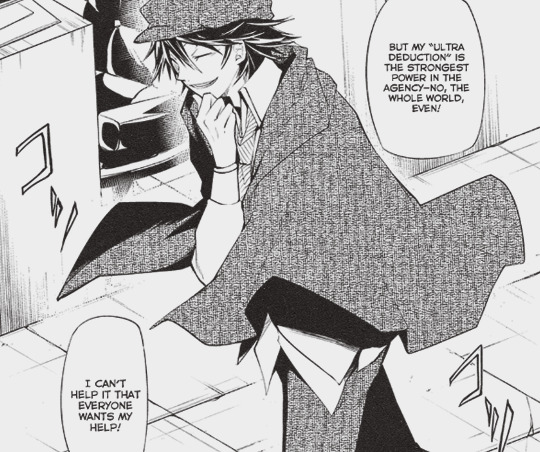
BSD VS. LITERATURE: MURDER ON D STREET
The third entry in my long-running series analyzes every literature reference in Bungou Stray Dogs and tries to piece together the author’s intention in referencing the work.
Ranpo’s the only character whose ability name does not reference a specific book, but his entire character seems to be a reference to Ranpo Edogawa’s collection of mystery novels and his life’s work in general. However, the first chapter to feature him is named after his first story facing his primary detective Kogoro Akechi. Let’s root out the references underneath the cut.
1. Poe and Ranpo
Ranpo the character is not just a reference to the original author’s work, he’s a tribute to the mystery genre and detective fiction in general.
Ranpo is an incredibly prolific mystery author in Japan. He is credited as one of the biggest influencers in the Japanese mystery tradition. He was an admirer of western mystery novels, especially Edgar Allan Poe, and tried to make his own more Japanese-inspired tradition of mystery novels.
“His chosen name, in combination with his frequent allusions to works on crime and detective by mostly Western authors, demands that the reader or critic compare Rampo’s work with that of the famous western writers he references and consider them all as belonging to the same category. Ranpo believed that a Japanese detective story could match the work of Western authors in the modern ratiocinative tradition they had established. Some of his works bear directly on the debates surrounding the issue, such as “The Case of the Murder on D. Hill” itself which Rampo intended as a response to critics who argued it was impossible to set the secret incidents and mysterious dealings which formed the core of the modern WEstern mystery in the open, wood-and-paper houses of Japan and that it was thus a natural result of the Japanese way of life that Japan should produce no strong mystery tradition of its own.”
Edogawa Ranpo - The Early Cases of Akechi Kogoro Introduction
Ranpo set out to write Japanese mystery stories written in a Japanese way, so eastern authors could establish their own traditions. In the same way, Ranpo in Bungou Stray Dogs is always interacting with other characters inspired by Mystery Authors, Edgar Allan Poe himself, and Mushitarou Oguri another Japanese crime novelist who was western inspired (He was known as the Japanese John Dickson Carr). Yokomizo was named after Seishi Yokomizo. His pen named Kindaichi is named after his private detective character “Kosuke Kindaichi.” In the same way that Ranpo was dedicated to helping Japan create its own mystery tradition, Ranpo himself is someone who gathers other detectives around him and befriends them.
The relationship between Edgar Allan Poe and Ranpo in BSD itself is also a pretty heavy reference to the influence both share in their respective genres. Edgar Allan Poe is largely credited as being the first mystery author and “Murders in the Rue Morgue” as the first modern detective story. In the same way that Edgar Allan Poe invented mystery novels and inspired Ranpo, Ranpo then went on to inspire mystery novels in the east and be formative for the Japanese mystery tradition.
2. Murder on D Street / The Case of the Murder on D. Hill
There are several references to Kogoro Akechi’s first case in the first real mystery to feature Ranpo in the manga. The first and most obvious is the title itself. However, the fact that the murder takes place when a corpse is discovered in a river is a reference to Ranpo’s chosen pen name. "Edogawa” which Ranpo chose as a pen name uses the characters for the Edo river which borders present-day Tokyo to the south and was originally the lower course of the Tone River.
His pseudonym incorporates the geography of Edo, the old capital of the isolationist Tokugawa Shogunate, with the name of Poe, an American writer. This contradictory composition reflects Rampo’s own efforts to create a uniquely Japanese tradition of an imported genre.
Edogawa Ranpo - The Early Cases of Akechi Kogoro Introduction
In D. Hill, the murder itself is a bit of a parody of more western mystery novels. Most of the deduction takes place when Akeichi and his friend the narrator are discussing the details of a particular case that appears to be a locked room. At first, the narrator makes a solid deduction in the way a Sherlock Holmes or Western detective would immediately jump to the conclusion of a case based on connecting a large amount of small evidence noticed at the crime scene.
The two characters themselves are also avid mystery readers and make references to several other mystery novels.
“I know you’ve read Poe’s the murders in the Rue Morgue ad Leroux’s The Mystery in the Yellow Room, and I’m sure you know that Rose Delacourt Case in Paris. Even now, a hundred years alter, there are still mysteries surrounding that curious murder case. I’m recalling it now. Isn’t the way the perpetrator of tonight’s incident departed without leaving a trace somewhat similiar?” said Akechi.
The Case of the Murder on D. Hill
This was Poe’s first real attempt to create a locked room in a traditional Japanese paper wall and sliding door room. Poe even draws attention to that fact.
“It’s often been said that the kind of serious crime you find in a western novel could never happen in a Japanese building, but I certainly don’t think so, because of incidents such as this one. Somehow or other, although I don’t know if I can, I feel that I’d like to try my hand at solving a real case, just once.”
The Case of the Murder on D. Hill
The narrator goes through the process of deduction and comes up with a likely-sounding theory, that’s just like the kind of clever solutions in one of those novels. However, he comes to the wrong conclusion because he was thinking in mystery novel logic and Akechi goes out of his way to correct him.
The Murder on D Street chapter in BSD is structured in the same way, at first there’s an obvious culprit to the crime only for Ranpo to reveal that the culprit framed it as the mafia and there was another story behind it. In both cases too, the murder victim was killed by accident by her own lover.
In a way, Ranpo in his work goes out of the way to both parody and comment on the western genre of mystery novels themselves. Akechi even highlights that some of the guesses that characters leap to in those novels are ridiculous.
“For example, concerning my relationship with that woman, have you made a thorough and psychological investigation inot what sort of childhood friends we were? Whether or not there had been a past love affair between us in the past/ Whether or not I bore a grudge against her? Those aren’t the story of things you can guess at, are they...?”
The Case of the Murder on D. Hill
Akechi points out that rather than solving mysteries by jumping to conclusions based on evidence he tends to solve people psychologically.
“My methods are a bit different from yours. Physical evidence and things of that kind can take all sorts of appearances depending on the point of view. The best method of detection is psychological: to see through the depths of people’s heart.”
The Case of the Murder on D. Hill
Perhaps about this, Ranpo the character is a genius who can puzzle together the culprit of a murder with just a few pieces of evidence. At the same time, he is completely unable to understand psychologically the way people around him think.
“I don’t understand what anyone’s thinking! I’m scared! It feels like I’m surrounded by monsters! It doesn’t matter what I say - nobody understands me! My parents were the only ones who did, and they’re dead!” BSD. VOL 3
Edogawa Ranpo the author also created a mystery series for children known as the “Boy Detectives Club”. Yoshio Kobayashi, the assistant of Kosuke Kindaichi starts a detective club of his own right by gathering other children from his own school. In the third light novel, Ranpo’s father is a reference to Akechi Kogoro himself.
The man was a legendary detective. The “Headless Officer” case, the “Moonlight Phantom,” the “Cow Head Incident” - he helped solve several difficult cases that shook the nation.
If his father was Kosuke Kindaichi, then naturally Ranpo himself would be a reference to Kobayashi the boy detective. Which also fits his role of gathering all the other detective characters and forming connections between them. He also gained fame for being a young genius detective, and it’s also how he gained his home and his place with Fukuzawa and the detective agency.
Ranpo is also, much like the author himself a character who does not have a power like the rest of the ability users, trying to still create a name for himself. Ranpo Edogawa was an inspired and talented enough author to basically rewrite the japanese mystery tradition into something more unique. Whereas, Ranpo the character despite having no ability of his own is the most important character in the agency fights on the front line with everyone else. The same way Ranpo influenced the entire mystery genre in Japan, Ranpo the character also is the main reason the detective agency was created and the reason they all stay together.
Which speaks a lot of the importance of both the author and the character.
#edogawa ranpo#bsd meta#edgar allen poe#edogawa ranpo bsd#edgar allen poe bsd#seishi yokomizo#mushitaro oguri#mushitaro oguri bsd#bungou stray dogs meta#bungou stray dogs
158 notes
·
View notes
Text
Anime of RKDD was so great and I feel their respect for Original mangas and Amano Akira.
One of indicates of it is Opening. The manga is many pays homage to SHERLOCK HOMES. Following suit, the opening pays homage to many famous mystery works. So there are many scenes in opening we hadn't seen in manga.
This was a hot topic of discussion among viewers. There are some Japanese works, I try to compile it.
1 : The Inugami Curse (Series of Detective Kosuke Kindaichi) by Seishi Yokomizo

This is one of poplar mystery novel series in Japan. Especially "The Inugami Curse" is most famous one. It has been visualized many times.
There is a women in left side of picture and her body like wrapped in brown flowers. There is a same body on the other side, but there are no heads there. One of the most striking scenes in this work which the head of the corpse is placed on top of flower doll. This work has the eeriness of a horror so I don't use picture of this scene here. If you have interest, please Google this "犬神家 花".
Or maybe you can feel somehow from this picture. It is one of the filming locations for this work.

2 : Murder on the Orient Express by Agatha Christie


It's a mystery work that is too well known. Murder in the train isn't happened on manga, well, at this time.
3 : Any Old Port in a Storm (Series of Columbo)


This picture by Colombo official Youtube (season3, episode2). It's very clear how faithfully it has been reproduced.
4 : The Case of the Murder on D by Edogawa Ranpo.
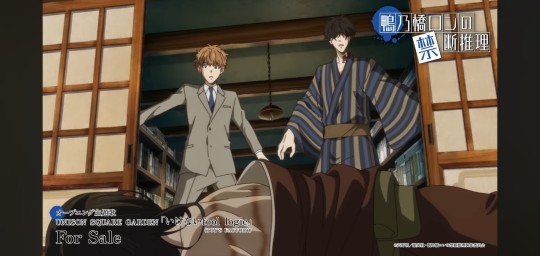
This is a mystery novel by one of Japan's leading writers. It's also the first work in which the famous Japanese detective Kogoro Akechi appears. On my research, it seems there isn't translation book to English. Nearly 100 years have passed since the publication of this work, so copyright has expired. Therefore, we can read it for free on a well-known in Japan and conscientious site. (It can also view other old works on this site, but all are in Japanese only.)
That's all! I think the anime is very wonderfully done. I can't wait to the 2nd season!
24 notes
·
View notes
Text
Translation: Katsura Hashino's 2008 Persona 4 Developer Interview (Parts 1/3/4)
I paraphrased and summarized parts of this interview before, but now, here is an actual full text translation... This was translated by Alex Highsmith of Shmuplations, a professional who has translated a ton of video game developer interviews before. I asked him to do these 3 specific parts as I believe they are the juiciest parts of this interview and probably the most interesting to people who are fans of Persona. Full text below the read me cause of how long it is. (゚Д゚*)ノ
You do not have permission to post anything from this interview on the god awful Fandom wiki.
--------
[[PART 1]]
--I understand the title "director" implies a range of different jobs, depending on the project in question, but would you mind explaining in detail what your role in Persona 4 entailed?
Hashino: Mainly, designing the systems and crafting the rules for the game. I also worked on the story outline and themes. I left the details up to the staff who were specifically in charge of the scenario and system design, but I would also make revisions and changes to the stuff they brought to me.
--That's actually a great transition for my next question: what is/are the theme(s) of Persona 4?
Hashino: The theme, um… it's a small-town murder mystery. (laughs) First and foremost, I wanted to make an RPG that would revolve around a murder mystery. After Persona 3, we worked on P3 FES, and we were developing P4 in tandem. I spent some time thinking about what the players who enjoyed P3 would find interesting in the next game--what would they like to see. From there, our ideas eventually took the shape you see today, of exploring a string of murders in a small country town.
--So, just to re-cap then: with P3 in mind, you decided to set this game in a completely different small town, then for the plot, you arrived at the idea of a serial murderer…? Is that about right?
Hashino: Well, not exactly--the "small country town" and "murders" ideas basically came together as a set in my mind. It's kind of a Kosuke Kindaichi vibe… I've always loved those kind of mysteries, where a person from the "big city" visits a small town, and during his stay he solves a mystery of some type.
--That reminds me of Kindaichi's works like Inugamike no ichizoku (The Inugami Clan) and Yatsuhakamura (The Village of Eight Graves). Do you like mystery novels, then?
Hashino: I'm not an expert or anything, but it's a genre I've enjoyed since I was younger.
--What are some of your favorite works?
Hashino: For older stuff, I like Arthur Conan Doyle and Agatha Christie. Also, he's a sci-fi author, but I also enjoy writers like Isaac Asimov. I love those classic older works, and when I was a kid that was all I read. You know there were those kids in elementary school, right? The ones for some reason would write all their book reports on mystery novels?
--Ah, yeah! There were some kids like that at my school too. (laughs) So then, why did you decide to add mystery elements to Persona 4?
Hashino: I think it should be obvious to players what's interesting about your game, and what kind of story it is, before they buy it. This is something I reflected on and realized after Persona 3, but for the earlier games, it was hard to know what they were about until you played them. So this time, the premise is simple and upfront: there is a murder incident in a small town, and the adults are oblivious to the truth of the situation. The protagonists then proceed to investigate--sort of like a Junior Detective League--and attempt to solve the mystery.
--You mentioned the earlier games and reflecting on them… am I right to assume you weren't only looking at P3, but were thinking about the whole flow of the series, all the way back to P1?
Hashino: No, in terms of being inspired to make the content of the game more obvious, I was talking about P3. The truth is, P2 and P2: Eternal Punishment were so long ago, I wasn't really thinking that far back. Plus the fans themselves consider P2: Eternal Punishment to have wrapped everything up. However, when the very first Persona came out, the developers then (my senior colleagues) were trying to make a new style of Megaten game, something that would appeal to more casual players. So for me personally, there was a sense of going back to the roots in wanting to do the same thing with P4.
--Would that include the basic question of "what are Personas…?"
Hashino: Yeah. We tried to depict these characters' struggle in a head-on, direct way, while at the same time returning to the fundamentals of the Persona series. That is, rather than thinking in terms of sequels and multi-part stories, we wanted to go back and once again ask ourselves, "OK, so what role were the personas really meant to occupy in this world…?" And what approach would be best to attract a new generation of users and show them the appeal of Atlus' RPGs…? We talked about what makes a Persona game a Persona game… were there necessary criteria? For example, with the progenitor of Persona, the Megami Tensei series, you've got the light side and the dark side, that contrast of exterior and interior (omote and ura)--if those are the foundations of Megaten, then what are Persona's…? Those were our questions as we began the development of P4, and to tell the truth, I was somewhat uneasy about the answers we would reach. When I look back at P3 now, it ended up being a big success, and ultimately that's the most important thing for any game.
--Did that anxiety stick with you until the reviews finally came in?
Hashino: I mean, there were people at Atlus saying stuff like, "Maybe we shouldn't have called it a Persona game…" and "This isn't Persona." (laughs) But the opinion of the players is the most important thing, so now I can say that I'm very satisfied.
--So do you know now precisely what makes something a Persona game?
Hashino: Hmm, well… one example, I guess, would be the "angsty" feeling of the games. When you're young, much of your life is managed for you by adults, but eventually everyone has to break out of that protective shell--and it's a bit like being on a train where the rails suddenly disappear, isn't it? Sooner or later, that time comes for everyone, but that de-railing provokes a keen sense of angst in many young people. Yet it's almost like we don't want to forget those times… there's a nostalgia for it, you could say. When you become an adult and are stressed out by your job, it's very difficult to find the time to re-discover yourself. I think it'd be cool if Persona can provide people a chance to re-experience that in game form, to go back to the beginning and reflect on it all once more. Of course, I don't think this is unique to Persona--there's a lot of works of art in the world that have a similar appeal.
[[PART III]]
--Going back a bit, I wanted to ask some more specific questions about the development process. What were some of the challenges you faced in creating a mystery?
Hashino: I'd say one big challenge was interweaving the real-world elements of the murders with this fantastic psychological world where you're battling with personas. I mean--OK, there's these murders, but then if all of a sudden a Shadow pops up out of nowhere, it would be like… "forget these murders, wtf is that!!" (laughs) Also, in P3 the dungeon fights were basically just for training, and in the beginning they don't have much connection to the story. We wanted to intertwine those more with the story, so for P4 we first came up with the idea of someone getting kidnapped, taken to this mysterious other world, and you have to go rescue them… and that led to us coming up with the serial kidnapping-murder part of the story.
--It sounds like rather than having a whole mystery story figured out from the get-go, you rather focused on how to artfully interweave the gameplay systems and main story.
Hashino: I often start from the end, so to speak, like coming up first with a catchphrase and working backwards from there. For this game, too, rather than working out the details of the story, I had more general situations in mind: a town is enveloped in fog and a person disappears -> the main character goes to rescue that person. Just that brief outline sounds exciting, right?
--That being the case, at what point did you come up with the character of the villain Adachi?
Hashino: Actually, this goes back to the discussions we had at the very beginning of the development when we were creating the plot, but one of the themes we hit upon was "how do we get our information." So initially, we wrote the true final villain as someone who mistakenly thought they were doing the right thing.
--Are you talking about Namatame?
Hashino: Yeah. And there was something manipulating him behind-the-scenes, and Adachi was not the villain then. However, as the development went on, we felt the story development was lacking in something, and it needed one more twist with regard to who the true culprit was. The first candidate for that role was Yukiko, actually. (laughs)
--What!!
Hashino: Yeah, I mean, when you think about "murders in a small town" stories like this, a Kindaichi story would have the killer be someone like the ryokan proprietress. (laughs)
--Oh yeah… I know what you mean.
Hashino: It was something I talked about Soejima with, only half-joking of course. The idea of Yosuke the villain also came up. He was a character with solid reasoning abilities and good judgement; it would be believable to players, we thought, that he could have plotted everything himself. We also discussed making the culprit a "likable villain". But we were hesitant about making one of your party members the killer.
--Being betrayed by a close friend like that would be quite painful indeed.
Hashino: But the biggest reason we thought Yukiko and Yosuke wouldn't work, was that we thought players would find it boring if we gave the killer a merely personal motivation for his crimes. That kind of simplistic motive belongs in the realm of Tuesday afternoon TV crime dramas. So we went back and re-examined our themes about information: and this links up with the notion of irresponsibility on the part of the person disseminating the info, but when you think about it, doesn't the responsibility for what happens with that information ultimately lie with the recipient? It's hard to explain, but yeah… we felt the connection between ill-intent and that kind of irresponsibility fit the game the best.
--And that's where Adachi comes in.
Hashino: Initially, Adachi was created as a character whose role is to facilitate the exchange of information between the protagonists and the police investigation. But he seemed a little out-of-place there amongst the other adult detectives, and personally, I started to worry that he would stand out to players as odd and it would be too obvious that he was the killer. So we switched gears midway through the development and took his character in a different direction.
[[Note: I spoke with Shmuplations about this particular part and he understands why this sounds confusing: Does Hashino's "initially" mean "Adachi's character existed before we needed a new culprit" or "we then proceeded to make the character of Adachi to be the new culprit"? While he believes the former is more likely, Hashino does not specify this within interview itself.
I believe this can be read in combination with what Soejima said about Adachi in the Design Works where he mentions Adachi used to be a red herring and then was re-designed after he became the culprit. This is further supported by the 2009 Gamasutra interview where Atlus talks about a villain character changing in development but their design being done before the change and the character's design not looking villain-like.]]
--That "something" manipulating Adachi was, of course, Izanami… was that also something that was revised midway through?
Hashino: Actually, Izanami was there from the very beginning. Even before we had the themes figured out for P4, in the previous games we'd used a lot of Greek gods, so we talked about how this time we wanted to focus on Japanese mythology. And so, around the time that we decided on the theme of uncertainty surrounding the truth and the rumors you're hearing in this small town, I thought these native gods and goddesses would be a force resisting that kind of social anxiety.
--I see. And the story of Izanami and Izanagi is one of the most well-known in Japanese mythology.
Hashino: As we worked out the plot, I took that story of Izanagi descending into the underworld (Yomi) and gave it my own expanded interpretation. In the myth, it is Izanagi's inability to accept Izanami's death that, ironically, nearly gets him killed by her: but I added my own interpretation, that the news and rumors we hear from all these sources == death (that is, it's an invitation for you to cease thinking).
--That's an unusual reading.
Hashino: At the time I thought to myself, "Nice, now this sounds like an idea that would be in a Persona game." (laughs) Izanami sees that humanity has stopped thinking critically for themselves and has surrendered to whatever they hear, and she thinks, "These unthinking people might as well be dead, so I will grant their wish. If I'm wrong, prove it to me." Then, when she happens to encounter certain humans that appear interesting to her, she bestows on them the power to change their reality, and that is how it all begins. But the protagonists are far stronger than she had thought, and though she had planned to merely be a spectator, they strike back in a way she hadn't expected. (laughs)
--Does the fact that she is defeated in the last battle mean that she had erred in her judgment?
Izanami: Yes, definitely. The ability Izanami uses in the battle, "Thousand Curses", I imagined it as a metaphor for all the lies the media tells. And likewise the ability the player uses, "Myriad Truths", that represents the trustworthy words of those people closest to you. I hope players get the message I was trying to convey, that no matter how much irresponsible, unverifiable information the world tries to deluge you with, you can always rely on the truths of your trusted friends to see you through.
--Whoa… that's deep!
Hashino: Also, the fact that there is a date and time that the world will end within the game--that day is meant to symbolize imported culture. There's a similar commentary with the native Japanese deities and a resistance to globalism. The way the Inaba shopping district resists the incursion of the Junes department store chain is part of that too.
[[PART IV]]
--I think the story of Persona 4 wraps up very neatly, but was it a smooth process, writing those scenarios?
Hashino: No, it took a lot of time and research to come up with plot twists, red herrings to throw players off the scent, and all the things you would expect to find in a proper mystery. There were a lot of additions and revisions too. As I mentioned above, in particular I wasn't satisfied with the plot development in the first draft, so aside from adding a "true villain" we also made a lot of changes. In the first draft, for example, we weren't originally planning to have Morooka die.
--What?!
Hashino: We had planned to include Mitsuo and the Void Quest, but we wanted to put a big surprise in there that would really betray player's expectations, and sadly for him, Morooka was sacrificed for that.
--It was kind of a shock.
Hashino: Many people told us that, yeah. It surprised us how popular Morooka was.
--He makes a bad impression on you on your first day at school, but there's many moments throughout the game where you realize he actually cares for the students' well-being.
Hashino: Hah, that's so funny, because I had no intention of making him that way.
--Oh, really?
Hashino: For me, Morooka was the kind of character you'd see in a typical school drama, basically just your typical unpopular homeroom teacher. But perhaps the staff in charge of that scenario had a lot of affection for Morooka, because they added all these extra details and episodes that gave depth to his character. So his popularity had nothing to do with me--it was all our staff.
--It really made that fight with Mitsuo intense. It was like, "THIS IS FOR MOROOKA!" (laughs)
Hashino: It got people fired up, didn't it? I'm glad his sacrifice was not in vain. (laughs)
--Speaking of unexpected stuff, the whole sequence when you're going to Yomotsu Hirasaka for the final fight with Izanami really took me by surprise. It was very difficult to find that route though.
Hashino: For the Normal Ending where you fight Adachi, we were hoping players would see that and feel a sense of closure: "ah, it's all over now." Then, say you still feel something isn't quite right, so you talk to a friend who saw the true ending, and when you go back and search and find the answer by yourself, it's like a fog has lifted from your own brain… I thought that would be cool, if your real-life gameplay experience sort of linked up with the game itself in that way.
--Ah, I can see that, definitely.
Hashino: Of course, partly I just wanted people to play to the very end of this game that we had put so much time into making… (laughs) In the beginning I was saying, "Let's keep it a secret for at least half a year."
--It seems like it must be tough to hide a true ending, or provide the right level of hints.
Hashino: Recently it feels like players are very sensitive to the dialogue, and can detect the slightest whiff of anything suspicious. That's why we put these hints at the very end, hidden in each party member's greetings. We made them say some things that just don't quite add up, hoping that players would suspect something is still hidden. Also, the fact that the Judgement Social Link isn't at MAX despite being so close to the ending is another hint that there might be something more.
[[Note: Judgement maxes after you clear Magatsu Inaba. This is not a translation error. It's an error that Hashino makes in the text.]]
--It sounds like a very tough balancing act. On the one hand, players will get bored if they know what's going to happen, but if things are too vague and opaque that's not good either.
Hashino: Exactly. To that end, when the final draft of the scenario is finished, we have the entire staff read through it to see if they spot anything weird. After reading it, one of our staff blurted out, "The Killer is Yasu!" (laughs)
[[Note: This is a reference to the Portopia Serial Murder Case.]]
--Ah, right, that famous spoiler from Portopia, where the detective's assistant Yasu is the killer. Now that you mention it, that does sort of match up with Adachi's position in P4. (laughs)
Hashino: It's a pretty old game though, so I figured there's no players today that would think that. Nevertheless, early on when we put Adachi's face in some of the magazine spots we did, there were apparently people who were saying "The Killer is Yasu!" in response to him… you see, actually, in the beginning, Adachi's first name used to be Tamotsu (保), which can also be read as "yasu", right? Maybe I'm overthinking it, I thought, but we were trying to really control the timing of the hints we fed to players about the killer, so we hurriedly changed his first name. Of course we'd already finished the voice recording, and there were lines like "Hello, I'm Tamotsu Adachi", so we had the sound staff re-edit those clips and cut the "Tamotsu" part off.
--Sounds like a lot of work.
Hashino: I never imagined "The Killer is Yasu!" was that well-known! (laughs)
[[PART 5]]
--Now that you mention it, because Adachi had a very famous voice actor, I bet that tipped off players to think, "Ah, Adachi must be the killer or someone important."
Hashino: Ah, yeah, that could be. I don't know a lot about voice actors, so I wasn't aware of that at all and merely chose the voice actor who I thought best fit the role. But many of the voice actors in Persona 4, not just Adachi's, received a lot of praise.
--------
You do not have permission to post anything from this interview on the god awful Fandom wiki.
18 notes
·
View notes
Text
I admit it. I fast-forward through the opening of Ron Kamonohashi's Forbidden Deductions. Mostly because I don't particularly like Union Square Garden's "Ikenai Fool Logic". I think it's too chipper.
But! because I kept fast-forwarding, I missed two interesting things.
First! The opening changes. After each mystery, the people walking through the town come into focus, revealing themselves.

The couple that was blurry in episode 2, for example, become more distinct in episode 4.
Second! The second half of the opening is a chase through different mystery adventures.
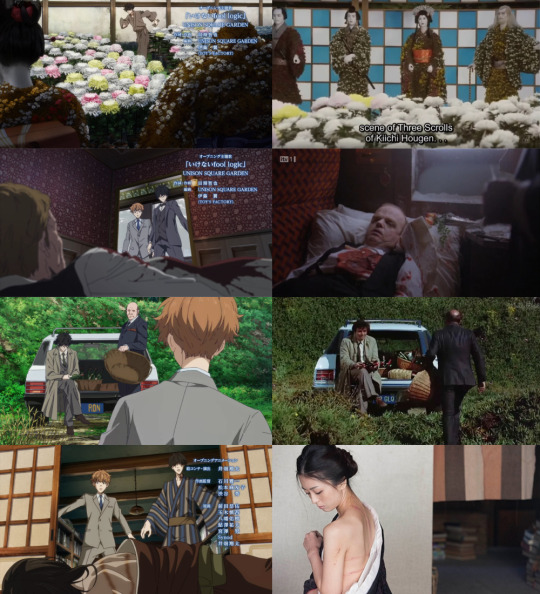
First, they run past chrysanthemums and richly-dressed mannequins borrowed from The Inugami Clan (犬神家の一族, Inugami-ke no ichizoku), and Kamonohashi is dressed like Kosuke Kindaichi, the fictional detective created by Seishi Yokomizo. The screenshot is from the 2006 film adaptation.
Second, Kamonohashi is in Poirot's suit and bow tie and they're on the Orient Express, opening the door to find a dead body in a train car. The screenshot is from the ITV series' adaptation from 2010.
Third, Kamonohashi dons an old trench coat and sits in the back of a car, bottle of wine in hand. "Any Old Port in the Storm", eh? The screenshot is from the second episode of Columbo, season 3.
Finally, the chase ends as they run into a bookstore and find another dead body, this time a woman with unusual marks on her back, referencing "The Case of the Murder on D. Hill" (D坂の殺人事件) by Edogawa Rampo, starring his fictional detective, Kogoro Akechi. The screenshot is from the 2015 adaptation.
I only figured out the Columbo one on my own. This tweet pointed out the others to me.
#ron kamonohashi's forbidden deductions#kamonohashi ron no kindan suiri#tv corner#and don't think i didn't notice the guy they were chasing#but i already posted about how i think bbc's sherlock influenced this.#and that one note is enough.
9 notes
·
View notes
Text
Alright, let's talk about Yokomizo! He was based on Yokomizo Seishi. And this Yokomizo Seishi is a... writer! What does it mean when you're based off a writer in BSD? You have an ability!
My theory is that his ability is based on "The Honjin Murders", according to Wiki, his most popular book. The book is about Kosuke Kindaichi, a detective, who has to solve a case of "a locked room" . This method of killing is used in BSD in Poe's novel, when he challenged Ranpo (ep. 22). But what could his ability be? Well, what if he's ability is solving any murder mystery? Like Ranpo's, but for real. And that's why he was writing mystery novels.
Anyway, even if that isn't his ability, why is he the only faceless character? I'm no expert, but when a character's face isn't shown it means he will be important and/or he was important in someone's background and this will be revealed later in the story (based on how the show is going, my money's on Dazai). And since Yokomizo is dead, he won't appear later (assuming Asagiri won't start bringing characters back to life). Which means we would get more information about him from someone else's backstory, not just Mushitaro's. Assuming my theory is right and he will appear in another light novel with Dazai's background, was he part of the Mafia? I doubt that. Then did he know Dazai from before his Mafia days?
Anyway, please, lemme know what y'all think.
#bungou stray dogs#bsd#dazai osamu#ranpo edogawa#theory#anime and manga#bsd mushitaro#mushitaro oguri#bsd yokomizo#seishi yokomizo#delulu fan#another crazy theory of mine
13 notes
·
View notes
Text
ccan i be crazy for a second as a Detective Media Consumer
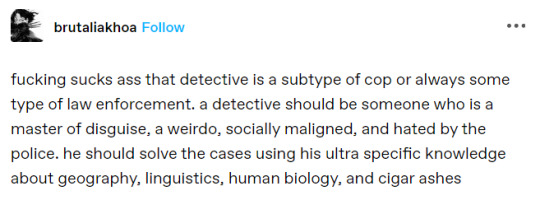
this post actually drives me nuts and normally i'd be like whatever everyone on the internet uses hyperbole but op clearly doesn't know much about the genre or archetype and the fact that a bunch of people who also don't know a lot about the genre agree with them is a littleee aggravating likeeeee
while they aren't wrong that plenty of fictional detectives are affiliated with law enforcement most of them are not
arguably the most influential ones aren't affiliated with law enforcement and hate cops, not just sherlock holmes
'all of them should be weirdos about-' they are. they are amateurs who enjoy mystery solving.
it's worth noting -- bc op brings up holmes in the tags of their og post -- that holmes popularizes the fictional detective archetype and that's why many of them are actually not police detectives
let's look at a few of them
philo vance: famously hated by the police, messes with investigations for fun
john dickson carr's gideon fell: another amateur detective, also annoys tf out of the police
edogawa rampo's akechi kogoro: literally a college student with a hobby (sound familiar?) who often runs circles around and deceives the police to get culprits off the hook when he feels like it
soji shimada's kiyoshi mitarai: an astrologer and college professor who gets brought cases by his crime enthusiast boyfriend, hates the police and nearly gets arrested by an officer for being disrespectful
seishi yokomizo's kosuke kindaichi: another amateur sleuth who's often underestimated by police investigators
yukito ayatsuji's kiyoshi shimada: a buddhist monk who solves mysteries part time because he's a mystery enthusiast
nisioisin's iichan: literal college student, solves mysteries because he happens to be there
nisioisin's jun aikawa: a freelancer in many fields who isn't solely a 'detective,' but isn't tied to any one organization or agency
etc etc etc
like yeah there are many detectives who are even p.i's that are often affiliated with or working with the police (L from death note, shawn spencer, etc) to act like they're typically written or portrayed like a cop character is so...??
when. a very clear, defining facet of the archetype is that they aren't part of the police force. and it's usually because these stories often feature officers as their culprits. like. .
not to mention that many of these characters are also meant to solve their crimes in unconventional ways, apart from the bureaucratic methods of a crime scene investigator - again they are Guys With a Hobby they're Mystery Enthusiasts and i'm sure a lot of authors find more freedom writing a private investigator than a cop because cops are supposed to wrap things up a certain way. they're supposed to be aiming for arrests. sometimes a detective doesn't want to do that. sometimes they want to solve the crime, lie to the police, and get the culprit off the hook bc they know the truth and don't think that the culprit deserves to get jailed and they dgaf if that's "right" or "wrong" in the eyes of the system
like i do think that a lot of more 'mainstream' media like criminal minds or CSI or whatever do portray a very different sort of detective but traditionally your fictional detective is a private investigator and their stories usually mandate that the police are incompetent, corrupt, etc in order to benefit the amateur sleuth who usually has poor rapport with them
it's definitely rarer to find detective media where zero cops are involved, i get it, but i think it's crazy to completely ignore that the entire genre originated from and is built off the backs of guys who cannot mind their own business to save their lives
#memo#unfort could not include ellery completely in my list either bc like#his dad is a cop and he does work with his father usually or like tries to help#but he is not a policeman hes just an english major#well okay 'mystery author' but w/e
5 notes
·
View notes
Text
Episode 154 - Murder Most Fun: Detective Byomkesh Bakshy! and Murder Mubarak
We are polishing our magnifying glasses and donning our deerstalkers, because once again, murder is afoot!
Show notes:
We just love murder mysteries!
Our Noirvember playlist
To Those Who Killed Me and Call of the Void, the mystery books Matt has edited
You can't have too few or too many characters in a murder mystery
Detective Bymokesh Bakshy!
"When the Hindu Right Came for Bollywood"
Byomkesh Bakshi
Comparisons to other famous fictional detectives
Kosuke Kindaichi
1940s setting
The music and the violence go too hard
INTERVAL ("Calcutta Kiss" from Detective Byomkesh Bakshy!)
Murder Mubarak
Is Sanjay Kapoor one of our guys?
"In a movie about rich people you can't kill the help"
Karisma Kapoor's first film in 12 years
Fantasy casting The Thin Man
NEXT TIME: Singer Movies
Find us on Apple Podcasts! and Stitcher! and audioBoom! and iHeartRadio! and Spotify! and Google Podcasts!
Thank you to Becca Dalke for the artwork!
Follow us on Twitter! Like us on Facebook!
#Detective Byomkesh Bakshy!#Byomkesh Bakshi#Dibakar Banerjee#Sushant Singh Rajput#Anand Tiwari#Neeraj Kabi#Swastika Mukherjee#Meiyang Chang#Murder Mubarak#Homi Adajania#Pankaj Tripathi#Sara Ali Khan#Vijay Varma#Karisma Kapoor#Dimple Kapadia#Sanjay Kapoor#Bollywood#Hindi Cinema
1 note
·
View note
Text




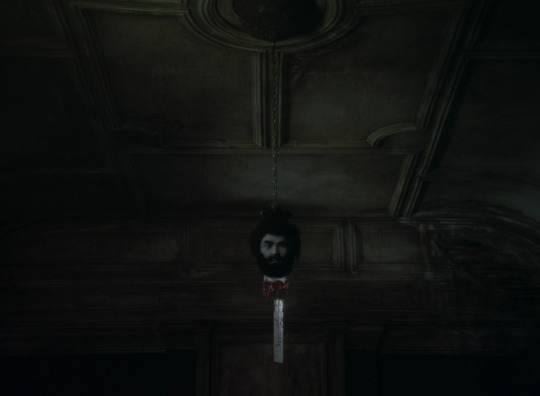
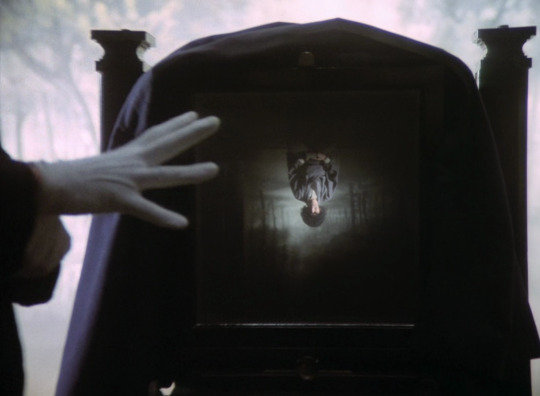

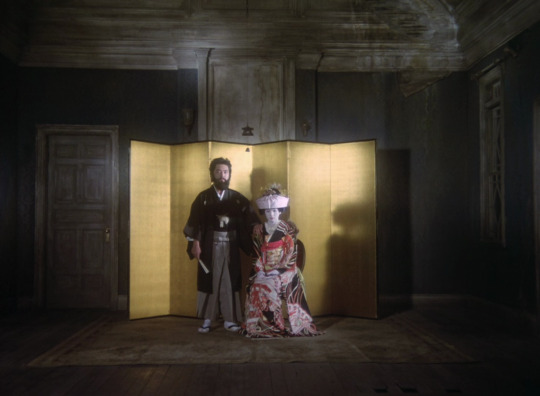


病院坂の首縊りの家 (Byoinzaka no Kubikukuri no Ie / The House of Hanging on Hospital Slope), 1979.
Dir. Kon Ichikawa | Writ. Kon Ichikawa & Shin'ya Hidaka | DOP Kiyoshi Hasegawa
#病院坂の首縊りの家#Byoinzaka no Kubikukuri no Ie#The House of Hanging on Hospital Slope#japanese film#1970s#murder mystery#detective film#kon ichikawa#kosuke kindaichi#kindaichi kosuke#10 frames
7 notes
·
View notes